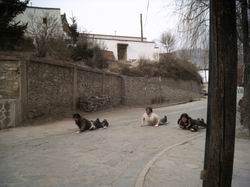The
reincarnation system for the Living Buddhas is the main point
distinguishing Tibetan Buddhism from other forms of Buddhism.

The term Living Buddha emerged in the early Yuan Dynasty (1271-1368)
when Emperor Kublai Khan honored Pagba, head of the Sagya Sect,
by granting him the title "Buddha of the Western Paradise.''
Thereafter, eminent Tibetan monks we distinguished them in the
practice of Buddhism were referred to as ''Living Buddha.'' However,
the term Living Buddha was not recognized as a special title for
a monk who became the successor of the deceased leader of a monastery
until the eventual introduction of the Living Buddha reincarnation
system.
In 1252 , Kublai Khan granted an audience to Pagba and Garma
Pakshi, an eminent monk with the Garma Gagyu Sect. Garma Pakshi,
however, sought the patronage of Monge Khan who proceeded to bestow
him a gold-rimmed black hat and a golden seal of authority. Prior
to his death in 1283, Garma Paksli penned a will to ensure the
established interests of his sect. The will advised his disciples
to locate a boy to inherit the black hat, with the instruction
based on the premise that Buddhist ideology is eternal, and a
Buddha would be reincarnated to complete the missions he had initiated.
Garma Pakshi's disciples acted in accordance with the will and
located the reincarnated soul boy of their master. The event marked
the introduction of the Living Buddha reincarnation system for
the Black-Hat Line of Tibetan Buddhism. During the Ming Dynasty
(1368-1644), Emperor Yongle honored Black-Hat Living Buddha Garmaba
as the ''Great Treasure Prince of Dharma,'' the first of the three
"Princes of Dharma.'' The Living Buddha reincarnation system
remains in operation today. On September 27, 1992, the Curpu Monastery
in Doilungdeqen County, Lhasa, was the site of a grand ceremony
marking the enthronement of the 16th Living Buddha Garmaba. The
event marked a new page in th history of the Garma Gagye Sect.
Various sects of Tibetan Buddhism reacted to the introduction
of the Living Buddha reincarnation system by creating numerous
similar systems. During the Qing Dynasty (1644-1911) reign of
Emperor Qianlong alone, 148 Grand Living Buddhas registered for
reincarnation with the Board for Mongolian and Tibetan Affairs,
with the number of registrants rising to 160 by the end of the
dynasty. The most influential reincarnation systems have since
been the Dalai and Bainqen Lama systems.
|



